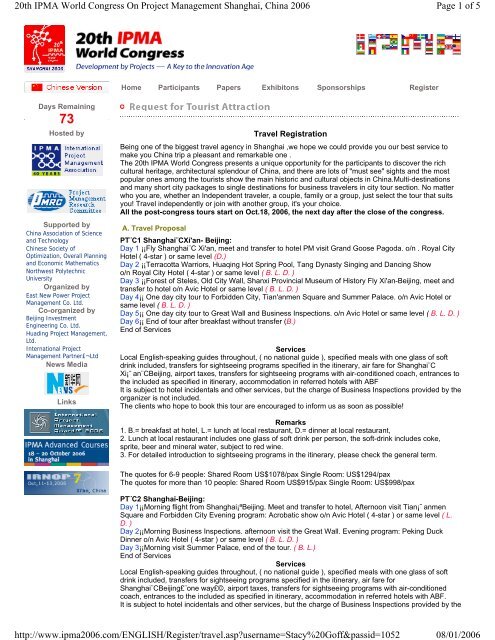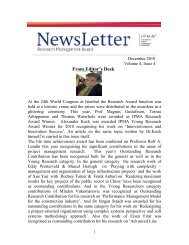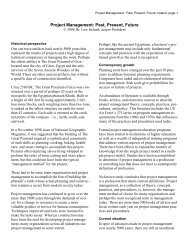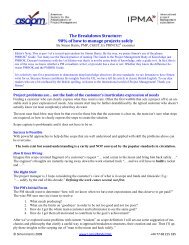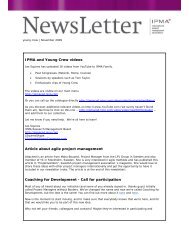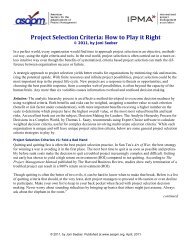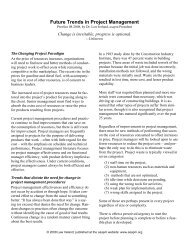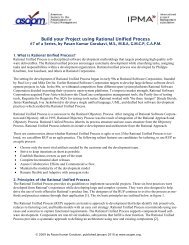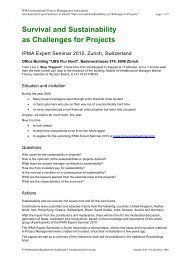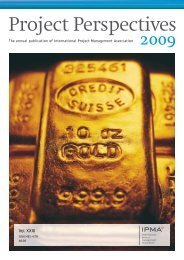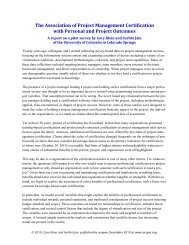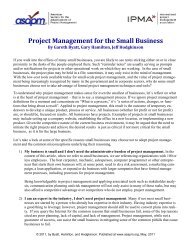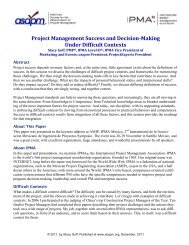of 5 20th IPMA World Congress On Project Management - asapm
of 5 20th IPMA World Congress On Project Management - asapm
of 5 20th IPMA World Congress On Project Management - asapm
You also want an ePaper? Increase the reach of your titles
YUMPU automatically turns print PDFs into web optimized ePapers that Google loves.
<strong>20th</strong> <strong>IPMA</strong> <strong>World</strong> <strong>Congress</strong> <strong>On</strong> <strong>Project</strong> <strong>Management</strong> Shanghai, China 2006<br />
Days Remaining<br />
73<br />
Hosted by<br />
Supported by<br />
China Association <strong>of</strong> Science<br />
and Technology<br />
Chinese Society <strong>of</strong><br />
Optimization, Overall Planning<br />
and Economic Mathematics<br />
Northwest Polytechnic<br />
University<br />
Organized by<br />
East New Power <strong>Project</strong><br />
<strong>Management</strong> Co. Ltd.<br />
Co-organized by<br />
Beijing Investment<br />
Engineering Co. Ltd.<br />
Huading <strong>Project</strong> <strong>Management</strong>,<br />
Ltd.<br />
International <strong>Project</strong><br />
<strong>Management</strong> Partner£¬Ltd<br />
News Media<br />
Links<br />
Home Participants Papers Exhibitons Sponsorships Register<br />
Travel Registration<br />
Being one <strong>of</strong> the biggest travel agency in Shanghai ,we hope we could provide you our best service to<br />
make you China trip a pleasant and remarkable one .<br />
The <strong>20th</strong> <strong>IPMA</strong> <strong>World</strong> <strong>Congress</strong> presents a unique opportunity for the participants to discover the rich<br />
cultural heritage, architectural splendour <strong>of</strong> China, and there are lots <strong>of</strong> "must see" sights and the most<br />
popular ones among the tourists show the main historic and cultural objects in China.Multi-destinations<br />
and many short city packages to single destinations for business travelers in city tour section. No matter<br />
who you are, whether an Independent traveler, a couple, family or a group, just select the tour that suits<br />
you! Travel independently or join with another group, it's your choice.<br />
All the post-congress tours start on Oct.18, 2006, the next day after the close <strong>of</strong> the congress.<br />
A. Travel Proposal<br />
PT¨C1 Shanghai¨CXi'an- Beijing:<br />
Day 1 ¡¡Fly Shanghai¨C Xi'an, meet and transfer to hotel PM visit Grand Goose Pagoda. o/n . Royal City<br />
Hotel ( 4-star ) or same level (D.)<br />
Day 2 ¡¡Terracotta Warriors, Huaqing Hot Spring Pool, Tang Dynasty Singing and Dancing Show<br />
o/n Royal City Hotel ( 4-star ) or same level ( B. L. D. )<br />
Day 3 ¡¡Forest <strong>of</strong> Steles, Old City Wall, Shanxi Provincial Museum <strong>of</strong> History Fly Xi'an-Beijing, meet and<br />
transfer to hotel o/n Avic Hotel or same level ( B. L. D. )<br />
Day 4¡¡ <strong>On</strong>e day city tour to Forbidden City, Tian'anmen Square and Summer Palace. o/n Avic Hotel or<br />
same level ( B. L. D. )<br />
Day 5¡¡ <strong>On</strong>e day city tour to Great Wall and Business Inspections. o/n Avic Hotel or same level ( B. L. D. )<br />
Day 6¡¡ End <strong>of</strong> tour after breakfast without transfer (B.)<br />
End <strong>of</strong> Services<br />
Services<br />
Local English-speaking guides throughout, ( no national guide ), specified meals with one glass <strong>of</strong> s<strong>of</strong>t<br />
drink included, transfers for sightseeing programs specified in the itinerary, air fare for Shanghai¨C<br />
Xi¡¯an¨CBeijing, airport taxes, transfers for sightseeing programs with air-conditioned coach, entrances to<br />
the included as specified in itinerary, accommodation in referred hotels with ABF<br />
It is subject to hotel incidentals and other services, but the charge <strong>of</strong> Business Inspections provided by the<br />
organizer is not included.<br />
The clients who hope to book this tour are encouraged to inform us as soon as possible!<br />
Remarks<br />
1. B.= breakfast at hotel, L.= lunch at local restaurant, D.= dinner at local restaurant,<br />
2. Lunch at local restaurant includes one glass <strong>of</strong> s<strong>of</strong>t drink per person, the s<strong>of</strong>t-drink includes coke,<br />
sprite, beer and mineral water, subject to red wine.<br />
3. For detailed introduction to sightseeing programs in the itinerary, please check the general term.<br />
The quotes for 6-9 people: Shared Room US$1078/pax Single Room: US$1294/pax<br />
The quotes for more than 10 people: Shared Room US$915/pax Single Room: US$998/pax<br />
Page 1 <strong>of</strong> 5<br />
PT¨C2 Shanghai-Beijing:<br />
Day 1¡¡Morning flight from Shanghai¡ªBeijing. Meet and transfer to hotel, Afternoon visit Tian¡¯anmen<br />
Square and Forbidden City Evening program: Acrobatic show o/n Avic Hotel ( 4-star ) or same level ( L.<br />
D. )<br />
Day 2¡¡Morning Business Inspections. afternoon visit the Great Wall. Evening program: Peking Duck<br />
Dinner o/n Avic Hotel ( 4-star ) or same level ( B. L. D. )<br />
Day 3¡¡Morning visit Summer Palace, end <strong>of</strong> the tour. ( B. L.)<br />
End <strong>of</strong> Services<br />
Services<br />
Local English-speaking guides throughout, ( no national guide ), specified meals with one glass <strong>of</strong> s<strong>of</strong>t<br />
drink included, transfers for sightseeing programs specified in the itinerary, air fare for<br />
Shanghai¨CBeijing£¨one way£©, airport taxes, transfers for sightseeing programs with air-conditioned<br />
coach, entrances to the included as specified in itinerary, accommodation in referred hotels with ABF.<br />
It is subject to hotel incidentals and other services, but the charge <strong>of</strong> Business Inspections provided by the<br />
http://www.ipma2006.com/ENGLISH/Register/travel.asp?username=Stacy%20G<strong>of</strong>f&passid=1052<br />
08/01/2006
<strong>20th</strong> <strong>IPMA</strong> <strong>World</strong> <strong>Congress</strong> <strong>On</strong> <strong>Project</strong> <strong>Management</strong> Shanghai, China 2006<br />
organizer is not included.<br />
Remarks<br />
B.= breakfast at hotel, L.= lunch at local restaurant, D.= dinner at local restaurant,<br />
Lunch at local restaurant includes one glass <strong>of</strong> s<strong>of</strong>t drink per person; the s<strong>of</strong>t drink includes coke, sprite,<br />
beer and mineral water, subject to red wine.<br />
For detailed introduction to sightseeing programs in the itinerary, please check the general term.<br />
Quotation<br />
The quotes for group <strong>of</strong> 6-9 persons:<br />
Shared Room US$408/pax Single Room: US$549/pax<br />
The quotes for group <strong>of</strong> more than 10 persons:<br />
Shared Room US$346/pax Single Room: US$434/pax<br />
PT- 3 Shanghai¨CChengdu¨CLhasa¨CChengdu-Xi'an-Shanghai:<br />
Day 1¡¡Fly Shanghai ¨C Chengdu, meet and transfer to hotel, At leisure o/n Mingshan Hotel ( 4-star ) or<br />
same level ( D. )<br />
Day 2¡¡Fly Chengdu ¨C Lhasa, meet and transfer to hotel, At leisure o/n Lhasa Hotel ( 4-star ) or same<br />
level ( B. L. D. )<br />
Day 3¡¡Visit Potala Palace, Barkhor Street o/n Lhasa Hotel ( 4-star ) or same level ( B. L. D. )<br />
Day 4¡¡Visit Norblinka, coach to Tseng Tang. o/n Tseng Tang Hotel ( 4-star ) or same level ( B. L. D. )<br />
Day 5¡¡Visit Tibetan King Tomb. o/n Tseng Tang Hotel ( 4-star ) or same level ( B. L. D. )<br />
Day 6¡¡Fly Lhasa ¨C Chengdu ¨C Xi'an o/n Bell Tower Hotel ( 4-star ) or same level ( B. L. D.)<br />
Day 7¡¡Visit Terracota Warriors, Banpo Neolithic Museum and Wild Goose Pagoda. o/n Bell Tower Hotel<br />
( 4-star ) or same level ( B. L.D.)<br />
Day 8¡¡Transfer to the airport, fly Xi¡¯an-Shanghai, end <strong>of</strong> the tour (B.)<br />
End <strong>of</strong> Services<br />
Services<br />
Local English-speaking guides throughout, (no national guide), specified meals with one glass <strong>of</strong> s<strong>of</strong>t<br />
drink included, transfers for sightseeing programs specified in the itinerary, air fare for Shanghai¨C<br />
Chengdu ¨C Lhasa ¨C Chengdu ¨C Xi¡¯an -- Shanghai, airport taxes, transfers for sightseeing programs<br />
with air-conditioned coach, entrances to the included as specified in itinerary, accommodation in referred<br />
hotels with ABF.<br />
It is subject to hotel incidentals and other services.<br />
Remarks<br />
B.= breakfast at hotel, L.= lunch at local restaurant, D.= dinner at local restaurant,<br />
Lunch at local restaurant includes one glass <strong>of</strong> s<strong>of</strong>t-drink per person, the s<strong>of</strong>t-drink includes coke, sprite,<br />
beer and mineral water, subject to red wine.<br />
For detailed introduction to sightseeing programmes in the itinerary, please check the general term.<br />
Quotation<br />
The quotes for the 6-9 people: Shared Room US$1689/pax Single Room: US$1962/pax<br />
The quotes for more than 10 people: Shared Room US$1434/pax Single Room: US$1700/pax<br />
CHOOSE:<br />
PT¨C1 Shanghai- Xi'an- Beijing<br />
PT¨C2 Shanghai-Beijing<br />
PT¨C3 Shanghai- Chengdu- Lhasa- Chengdu-Xi'an-Shanghai<br />
B. Introduction <strong>of</strong> Places<br />
¡ó Beijing<br />
The entire area <strong>of</strong> Beijing within the city limits is - in many ways -<br />
one great historic museum. The original city plan was divided in<br />
four. The innermost rectangle is the Forbidden City, now a<br />
museum and public park, but formerly the residence <strong>of</strong> the Ming<br />
and Qing emperors. The second rectangle forms the boundaries<br />
<strong>of</strong> the Imperial City, enclosing residences and parks for the<br />
former senior government <strong>of</strong>ficials. The outer rectangle forms<br />
the outer city with its markets and old residential districts. The<br />
Imperial Palace, lying inside the Forbidden City and surrounded<br />
by a high wall and broad moat, is probably China¡¯s greatest<br />
surviving historical site. Dating from the 15th century, the Palace<br />
was home to a total <strong>of</strong> 24 emperors and, today, its fabulous<br />
http://www.ipma2006.com/ENGLISH/Register/travel.asp?username=Stacy%20G<strong>of</strong>f&passid=1052<br />
Page 2 <strong>of</strong> 5<br />
08/01/2006
<strong>20th</strong> <strong>IPMA</strong> <strong>World</strong> <strong>Congress</strong> <strong>On</strong> <strong>Project</strong> <strong>Management</strong> Shanghai, China 2006<br />
halls, palaces and gardens house a huge collection <strong>of</strong> priceless relics from various dynasties. The<br />
surviving city walls are impressive monuments, as are the traditional hutongs, enclosed neighborhoods <strong>of</strong><br />
alleys and courtyards. Other points <strong>of</strong> interest are the Coal Hill (Mei Shan), a beautiful elevated park with<br />
breathtaking views; Beihai Park, the loveliest in Beijing; Tiananmen Square, the largest public square in<br />
the world, surrounded by museums, parks, the zoo and Beijing University; the Temple <strong>of</strong> Heaven, an<br />
excellent example <strong>of</strong> 15th-century Chinese architecture; the Summer Palace, the former court resort for<br />
the emperors <strong>of</strong> the Qing Dynasty reconstructed in traditional style in the early 1900s after Western<br />
attacks, looking out over the Kunming Lake; the Great Wall (see below), the section at Badaling being<br />
some 72km (45 miles) from Beijing; and the Ming Tombs, where 13 out <strong>of</strong> the 16 Ming emperors chose to<br />
be buried. Two magnificent tombs here have been excavated, one <strong>of</strong> which is open to the public.<br />
Tian¡¯anmen Square<br />
Located at the center <strong>of</strong> Beijing City is Tiananmen Square, where you can visit Tiananmen Tower,<br />
Monument to the People's Heroes, Great Hall <strong>of</strong> the People, Mao Zedong Memorial Hall and see the<br />
national flag raising ceremony. Thousands <strong>of</strong> people come to the Square every day.<br />
Forbidden City<br />
The Forbidden City (known <strong>of</strong>ficially as the Imperial Palace<br />
Museum) was commissioned by the third Emperor <strong>of</strong> the Ming<br />
Dynasty, Emperor Yong Le. The palace was built between 1406<br />
and 1420, but was burnt down, rebuilt, sacked and renovated<br />
countless times, so most <strong>of</strong> the architecture you can see today<br />
dates from the 1700¡¯s and on wards. The Forbidden City was<br />
the seat <strong>of</strong> Imperial power for 500 years, and is now a major<br />
tourist attraction in China. The total area <strong>of</strong> the complex is 183<br />
acres, so it takes quite a while to walk through, especially if you<br />
want to have a close look at everything. All together there are<br />
9,999 1/2 rooms in the Museum, not all <strong>of</strong> which can be visited.<br />
Great Wall<br />
A symbol <strong>of</strong> ancient Chinese civilization, the Great Wall has<br />
stood for more than 2,000 years. The wall was built in stages<br />
from the 5th century BC up to the 16th century AD as protection<br />
against northern nomadic tribes. Stretching from the coast <strong>of</strong> the<br />
Bohai Bay in the east and ending at the Jiayu Pass in the west,<br />
it snakes along the back <strong>of</strong> mountains, deserts and valleys for<br />
6,350km (3900 miles). It is said to be 1 <strong>of</strong> the only 2 human<br />
engineering projects visible by astronauts from space with the<br />
naked eye. Built <strong>of</strong> huge granite slabs and special sized bricks,<br />
the Great Wall at Badaling 75km (47 miles) north <strong>of</strong> Beijing is<br />
most typical <strong>of</strong> the Wall during the Ming dynasty (1368-1644).<br />
There the wall is wide enough for 5 horsemen to ride abreast or 10 men to walk side by side.<br />
Summer Palace<br />
Summer Palace is a favorite among tourists sightseeing in<br />
Beijing. Indeed, it is one <strong>of</strong> the best parks in the city. Originally it<br />
was a retreat for emperors to escape the scorching summer heat<br />
<strong>of</strong> Beijing. The Summer Palace was used by emperors for 800<br />
years, but fell into disuse in the 18th century. Then in the 19th<br />
century, the Empress Dowager Cixi made massive renovations<br />
and restored many buildings using money funneled out from the<br />
state treasury.<br />
Temple <strong>of</strong> Heaven<br />
Hutong Tour<br />
This tour takes you back<br />
to the old days <strong>of</strong> Beijing.<br />
Hutong is the Chinese name for the ancient city alleys and narrow<br />
lanes originally built in the Yuan Dynasty, where neighborhoods<br />
are made up <strong>of</strong> traditional courtyard-style homes. Ride in an oldfashioned<br />
pedicab through the Hutong district during this guided<br />
tour.<br />
Beijing Night Show<br />
Page 3 <strong>of</strong> 5<br />
China's largest temple<br />
and altar complex, the Temple <strong>of</strong> Heaven in the southern part <strong>of</strong><br />
Beijing covers an area <strong>of</strong> 270 hectares. The Temple <strong>of</strong> Heaven<br />
is an exquisite and extraordinary example <strong>of</strong> Chinese religious<br />
architecture. Construction <strong>of</strong> the temple began in 1420 and at<br />
the temple emperors <strong>of</strong> the Ming and Qing dynasties<br />
worshipped heaven and prayed for abundant harvests.<br />
http://www.ipma2006.com/ENGLISH/Register/travel.asp?username=Stacy%20G<strong>of</strong>f&passid=1052<br />
08/01/2006
<strong>20th</strong> <strong>IPMA</strong> <strong>World</strong> <strong>Congress</strong> <strong>On</strong> <strong>Project</strong> <strong>Management</strong> Shanghai, China 2006<br />
Beijing<br />
Night Show Beijing Night<br />
<strong>of</strong>fers a show named The<br />
Great China, which is a<br />
performance displaying<br />
traditional Chinese historical<br />
culture. The show is<br />
composed <strong>of</strong> 6 scenes and<br />
each one tells a famous<br />
historic story by the splendid<br />
and wonderful performance.<br />
3 <strong>of</strong> them are named Ceremony <strong>of</strong> the Imperial Palace, Romance <strong>of</strong> White Snake and The Splendor <strong>of</strong><br />
the Forbidden City. Guests from home and abroad give high praises for the performance <strong>of</strong> The Great<br />
China.<br />
Peking Opera: An art genre that is more than 200 years old, Peking opera<br />
dazzles the eyes with elaborate make-up and costumes, enchants the ears<br />
with beautiful melodies and grabs the hearts with complicated dramas. This<br />
performing art lures those who are keen to learn about the Chinese culture.<br />
¡ó Shanghai<br />
This is one <strong>of</strong> the world¡¯s largest cities and one <strong>of</strong><br />
China¡¯s most famous - more like New York or Paris than<br />
Beijing. Lying on the estuary <strong>of</strong> the Chang Jiang<br />
(Yangtze) River, it is the center <strong>of</strong> China¡¯s trade and<br />
industry. European-style architecture, traditional Chinese<br />
buildings and sleek modern developments all co-exist in<br />
this cosmopolitan metropolis. The Yuyuan Gardens date<br />
back over 400 years: although relatively small, they are<br />
impressive thanks to their intricate design, with pavilions,<br />
rockeries, ponds and a complete traditional theater woven<br />
together in an ornate maze. The gardens are reached via<br />
the Town God Temple Bazaar, a touristy but impressive<br />
warren <strong>of</strong> lanes and stalls. The French Concession area has quiet, characterful colonial parks and<br />
neighborhoods, while the Bund along the Huangpu River has the celebrated strip <strong>of</strong> Art Deco towers.<br />
From here, the dynamic new Pudong Development Area and the Oriental Pearl Tower can be viewed<br />
across the water.<br />
¡ó Xi¡¯an<br />
Pagoda.<br />
The capital <strong>of</strong> Shaanxi Province and <strong>of</strong>ten regarded as the true historic capital <strong>of</strong><br />
China, Xi¡¯an was once amongst the most magnificent cities in the world. For 11<br />
dynasties, from the 11th century BC, the city was also the capital <strong>of</strong> China. It was<br />
the starting point <strong>of</strong> the ancient trade route with the West known as the Silk Road<br />
(see Silk Road section) and is now, after Beijing, the most popular tourist<br />
attraction in China. The city is most famous for the Tomb <strong>of</strong> Emperor Qin Shi<br />
Huangdi, who first united China under the Qin Dynasty in 200 BC, and its<br />
terracotta figures - over 6000 life-sized Terracotta Warriors and horses buried<br />
along with the emperor. Many other tombs from the Han and Tang Dynasties are<br />
still unexcavated. Despite damage inflicted during the Cultural Revolution, there<br />
are still numerous tombs, pavilions, museums and pagodas to be seen, such as<br />
the Big Wild Goose Pagoda with its spiral staircase, and the Small Wild Goose<br />
http://www.ipma2006.com/ENGLISH/Register/travel.asp?username=Stacy%20G<strong>of</strong>f&passid=1052<br />
Page 4 <strong>of</strong> 5<br />
08/01/2006
<strong>20th</strong> <strong>IPMA</strong> <strong>World</strong> <strong>Congress</strong> <strong>On</strong> <strong>Project</strong> <strong>Management</strong> Shanghai, China 2006<br />
¡ó Tibet (Lhasa)<br />
Tibet (in Chinese Xizang), a rich and beautiful land, is located at the main part <strong>of</strong> Qinghai-Tibet plateau,<br />
south-west frontier <strong>of</strong> China. Tibet borders with Sichuan, Yuannan, Qinghai And Xinjiang; to the south<br />
contiguous to India, Nepal, Sikkim, Bhutan and Burma, and bounded by Kashmir on the west.It covers an<br />
area <strong>of</strong> 1.2 million sq km and has a population <strong>of</strong> 2.7 million.Tibet has a unique culture <strong>of</strong> all his own.<br />
Tourist attractions include the Potala Palace in Lhasa, Jokhang Temple, and a number <strong>of</strong> Buddhist sacred<br />
places. Lhasa, the heart and soul <strong>of</strong> Tibet and an object <strong>of</strong> devout pilgrimage, is still a city <strong>of</strong> wonders.<br />
The Potala Palace:<br />
This architectural wonder is Lhasa' cardinal landmark for its imposing scale and unique style. It's located<br />
on the Red Hill, covers an area <strong>of</strong> 41 hectares. It was first set up in the 7th century. The present<br />
architectural group is devided into two parts the red Palace and the white Palacethe. The former is<br />
composed <strong>of</strong> the tombs <strong>of</strong> eight Dalai Lamas, the monks' assembly hall, numerous chapels and shrines,<br />
and libraries for Buddhist Scriptures, while the latter was for secular use which conmtains living quarters,<br />
<strong>of</strong>fices, the seminary and the printing house. Palace is the largest museum <strong>of</strong> cultural relics in Tibet.<br />
The Potala, a vast white and ochre fortress, dominates the Lhasa skyline. <strong>On</strong>ce the seat <strong>of</strong> Tibetan<br />
government and the location <strong>of</strong> the tombs <strong>of</strong> previous Dalai Lamas, the Potala serves as a symbolic focus<br />
for Tibetan aspirations <strong>of</strong> self-government.<br />
Jokhang Temple:<br />
Jokhang Temple,built in 647A.D and located in the centre <strong>of</strong> old town Lhasa, it is one <strong>of</strong> the earliest<br />
constructions in Tibet ,its ro<strong>of</strong> is covered gold,making much <strong>of</strong> a sight. Through several renovations it<br />
expanded into quite a large group <strong>of</strong> buildings and now covers an area <strong>of</strong> over 25,000 sq meters. A large<br />
number <strong>of</strong> precious.Walls along lobbies and inner temples are covered with legendary frescoes.The are<br />
Tang willow and and the llnite Stela <strong>of</strong> Tand andtibet in the front.<br />
It is the spiritual center <strong>of</strong> Lhasa and stands in the heart <strong>of</strong> the old city.The medieval push and shove <strong>of</strong><br />
crowds, the street performers, the stalls hawking everything from prayer flags to jewel-encrusted yak<br />
skulls, and the devout tapping their foreheads to the ground at every step is an exotic brew that few<br />
newcomers can resist.<br />
Jokhang has 4 stories and its ro<strong>of</strong>s are covered with gilded bronze tiles. It was built in the style <strong>of</strong> Tang<br />
dynasty structures and adopted the characteristics <strong>of</strong> Nepalese and Indian architecture.<br />
There are numerous elaborately decorated shrines and rooms at Jokhang. There are also statues <strong>of</strong> King<br />
Songtsan Gambo together with his Chinese bride Princess Wen Cheng and Nepalese bride Princess<br />
Chizun in the side halls. In the center <strong>of</strong> the main hall, a gold statue <strong>of</strong> the young Buddha Sakyamuni,<br />
brought to Tibet by Princess Wen Cheng from Chang'an (present Xian) is enshrined.<br />
Copyrights©: <strong>Project</strong> <strong>Management</strong> Research Commission, China 2006-2006, All rights Reserved<br />
Technical Support£ºBeijing Investment Engineering Co, LTD. P. R. China<br />
Contact Us:¡¡Tel: +86 10 6298 8601¡¡Fax£º+86 10 6297 6304¡¡E-mail: ipma@ipma2006.com<br />
http://www.ipma2006.com/ENGLISH/Register/travel.asp?username=Stacy%20G<strong>of</strong>f&passid=1052<br />
Page 5 <strong>of</strong> 5<br />
08/01/2006


